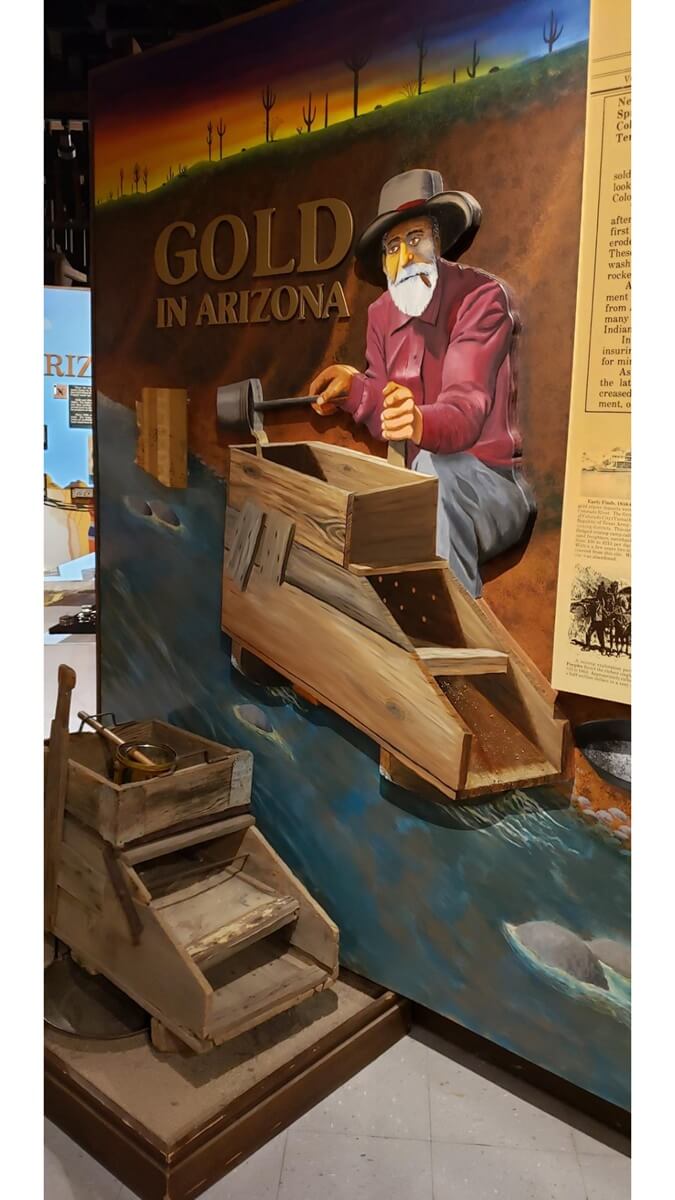The Arizona History Museum is housed in a beautiful, historic building in the heart of Tucson, Arizona. The museum is the Arizona Historical Society’s home, and is loaded with historical treasures in excellent displays. It is a depository of thousands of historic artifacts, documents, manuscripts, and memorabilia. Spanish colonial silver, decorative art, minerals, an underground mine replica, and an imposing two-story tall stamp mill are some of the treasures that gem and mineral lovers will definitely appreciate.
The Arizona Historical Society (AHS) was established in 1864, when Arizona was still a Territory. This non-profit organization serves as the steward of Arizona’s history by documenting the past, recording contemporary events, collecting and preserving Arizona’s history. The society’s logo features a large X, the alchemist symbol for copper. Alchemy is the forerunner of modern chemistry, and copper was one of alchemy’s seven metals. Copper is one of Arizona’s major economic historic developments and one of the state’s 5 C’s; the others are Cattle, Cotton, Citrus, and Climate.
Touring the Arizona History Museum
Last year, my husband, my sister and I had the opportunity to visit this museum. We started our self-guided tour at the "Arizona History 101" exhibit wall, which points out important themes and topics from Arizona’s history. A series of maps show how Arizona’s boundaries changed over time.
In the first main gallery, "Colonizing America", the impact of European colonization of this region is explored. During the late 18th century Spanish missionaries began building missions in Southern Arizona and Sonora, Mexico, in their effort to convert Native Americans to Catholicism to “save” and “civilize” them. They introduced their culture, cattle and crops that changed this region for ever.

Native American & Colonial, This exhibit features Native American ancient tools including a mano and metate probably Hohokam, flint scrapers, pottery shards, and Spanish colonial religious paintings.
Exhibit cases include Native American ancient tools including a mano and metate (probably Hohokam), flint scrapers, pottery shards, and Spanish colonial religious paintings. We were fascinated with the massive amount of Spanish colonial silver on display. Among it, a stunning solid silver chest dates from the 1600s, and a set of twelve silver dessert spoons from around 1820-1840. Also on exhibit is a repoussé silver tureen — a deep dish bowl from which soup is usually served — from circa 1700s, and candle sconces made from an old Spanish silver mirror.

Spanish silver, Among the massive amount of Spanish colonial silver on display are this stunning solid silver chest from the 1600s and a set of twelve silver dessert spoons from around 1820-1840.
Where did all this silver come from? The Spanish discovered rich silver deposits in New Spain (Mexico) and Peru. They mined around 35 million pounds of silver and 400,000 pounds of gold between 1500 and 1650 AD, all sent back to Spain. Native people were forced to become laborers in the mines; some were paid, while others were slaves.
Another great exhibit, "Geronimo – Revered and Reviled", highlights the legend behind the famous Apache warrior. On prominent display is the rifle Geronimo surrendered to Indian Agent John Clum in 1877. In the Transportation Room, visitors can explore an oxen-driven wagon, carriages, an iconic western wagon, and a 1923 Studebaker car. A great place for reflection is the January 8th Community space, and the Courtyard with remnants of the Otero House porch. A fully-stocked gift shop offers books, children’s toys, jewelry, and souvenir items.
The Arizona Mining Hall

Large copper specimen, A large native copper specimen from the Ray Mine is prominently featured at the Arizona Mineral Hall’s entrance.
We were pleasantly surprised to see a large mineral collection as part of the Arizona Mining Hall. At the entrance, a large native copper specimen from the Ray Mine is prominently featured. Also there, is a huge polished malachite specimen weighing 500 pounds mined at the Morenci Mine (at the time owned by Phelps Dodge). It was extracted at a depth of over 4,800 feet. The minerals on exhibit are courtesy of the Arizona-Sonora Desert Museum and the American Mining Hall of Fame. The specimens are part of the museum’s permanent collection which includes 12,000 specimens from Arizona, Sonora Mexico, and Baja California. Exceptional specimens of native copper, calcite, azurite, and chrysocolla give a representation of the state’s rich mineral wealth.

Malachite specimen, Also at the entrance of the Arizona Mineral Hall, is a huge polished malachite specimen weighing 500 pounds mined at the Morenci Mine.

Extensive mineral collection, An extensive mineral collection includes 12,000 specimens from Arizona, Sonora Mexico, and Baja California.
We loved the "Gold in Arizona" exhibit with a beautiful mural depicting a gold prospector with his shaker and a real wooden gold-shaker artifact. Highlighted is the importance of the thousands of prospectors who came to Arizona looking for placer gold and silver veins and loads. When a claim was located, the prospector usually sold it to a mine developer. The exhibit "Mines Brought Cities" gives visitors an understanding of how important the mines were to the establishment of the Arizona towns and cities. The photos and objects in the "Life in a Mining Town" give a glimpse of everyday life.

Gold in Arizona, We loved the Gold in Arizona exhibit with a beautiful mural depicting a gold prospector with his shaker and a real wooden gold-shaker artifact.
The brightly-colored wall of "Minerals of Arizona" with a map, geology graphics, and rough specimens of gold, silver, copper oxide, and copper sulfide ores, is a wonderful educational and interactive exhibit. The "Railroads Spurred the Rise of Copper" exhibit explains how the railroad’s cheap transportation after the 1850s’ helped the increase of copper mine production. The "Silver – Arizona’s First Industry" educational exhibit along with a small case full of beautiful silverware, introduces visitors to Arizona’s history of silver mining, which begun in 1856 and in the 1870’s and 1880’s became Arizona’s economic base.

Arizona’s Silver, The Silver – Arizona’ First Industry educational exhibit introduces visitors to Arizona’s history of silver mining, which begun in 1856.
Underground Mine Replica
We entered the underground mine replica just as an 1870’s miner would. The large exhibit explains how massive ore is handled to make low-grade ore profitable. New techniques including block carving — an underground mass-producing technique — and open pits contributed to lowering mining costs.

Underground mine replica, We entered the underground mine replica just as an 1870’s miner would.
Around the corner, a two-story-tall, five-stamp mill takes your breath away. It is a huge piece of mining equipment, necessary to break down large ore chunks into smaller pieces. More mining equipment fills the room. This fabulous interactive exhibit includes an assayer’s office, repair shop, and a miner’s tent.

Five-stamp mill, A two-story tall five-stamp mill, which broke-down large ore chunks into smaller pieces, takes your breath away.
Treasures of the Arizona Historical Society
A special exhibit area is the "Treasures of the AHS" collection. Along decorative art, Old West firearms and personal items, another case is full of Mexican silver. This exhibit of magnificent silver tableware includes a swan spice holder, candelabrum with hanging grapes, plates, tea pots, a turkey incense burner, and a large 16th century silver-domed chest. This Spanish colonial chest, originally owned by the Ramirez family of Buenos Aires, was sold at a New York auction in 1928. A Tucson collector of Hispanic decorative arts, Mrs. Helen Murphy, was able to locate items from the collection of Francisco Ramirez de Velasco, who was viceroy of Peru in 1590 and 1607, and donated them to AHS.
Mexican Silver
The Spanish conquistadors first discovered silver in Mexico in 1522 at Taxco in the state of Guerrero, followed by the mine at Pachuca in 1524, and in 1540 the great deposit at Zacatecas. Even richer silver deposits were discovered at Guanajuato in 1548. Mexico proved to be a silver bonanza and mining continued for the next centuries. In 1803, Prussian-born Baron Alexander von Humboldt, a naturalist, geologist and explorer, traveled though Mexico, and reported on the silver mines in Taxco and Guanajuato, and on finds of native silver, some weighing over 440 pounds (Political Essay, Von Humboldt, 1824).

Spanish silver, This magnificent Spanish silver tableware exhibit includes a swan spice holder, candelabrum with hanging grapes, plates, tea pots, a turkey incense burner, and a large 16th century silver domed chest.
One of the metalwork techniques used in Mexican silversmithing was repoussé (from the French meaning pushed-up). This technique was used as early as 3000 BC in the Middle East, in Egypt since 1400 BC, and around 400 BC during Greek Hellenistic times. In the Americas, repoussé was used since 900 BC in Peru, and later in Mexico by the Aztec civilization. The silversmith uses a hammer (martillo) and a cylindrical tool — a burr of various sizes known in Spanish as emputador. The design is then hammered from the reverse side on a malleable silver sheet over a wooden base.
The ancient art of silversmithing in Mexico was revived in the late 1920’s, when North American architect William Spratling went to the mountain village of Taxco in Mexico and became enamored with the Pre-Columbian artifacts and contemporary indigenous crafts. Spratling founded the Taller de Las Delicias silver workshop and a whole new generation of masters emerged creating artworks with Aztec and Mixtec ancient-inspired designs. (Mexican Silver 20th Century, Penny C. Morrill & Carole A. Berk, 2001)
Ready to Launch, Arizona’s Place in Space
This new exhibit "Ready to Launch — Arizona’s Place in Space" gives a great insight to Arizona’s contribution to space exploration, the impact people, and the research institutions. On exhibit are the AFA7UGA control room and newspapers from around the world announcing Man on the Moon. Northern Arizona’s landscape provided a rich training ground for NASA astronauts, and Arizona’s dark skies allow scientists to use telescopes to explore the night sky, making the state a leading center for scientific discovery of the universe. We loved Buzz Aldrin’s complete space suit and Senator Mark Kelly’s blue suit and helmet.
Getting There
The Arizona History Museum is located at 949 E. 2nd Street near the University of Arizona campus. It is open Tuesday through Saturday, from 10am to 2pm. Visit their website at www.azhs.org/tucson or call 520.628.6774. The AHS museum offers one more option to delve into Arizona’s mining history. Along with the nearby newly-opened Alfie Norville Gem & Mineral Museum, hopefully both museums will attract many gem, mineral, jewelry, and history-loving visitors.

Helen Serras-Herman, a 2003 National Lapidary Hall of Fame inductee, is an acclaimed artist with 40 years of experience in unique gem sculpture and jewelry art. See her work at www.gemartcenter.com and her business Facebook page at Gem Art Center/Helen Serras-Herman
All Photos by Helen Serras-Herman
Cover Photo: Arizona History Museum, The Arizona History Museum is housed in a beautiful, historic building in the heart of Tucson, Arizona.
Also Pictured: The Arizona Historical Society’s logo, The Arizona Historical Society’s logo features a large X, the alchemist symbol for copper.




